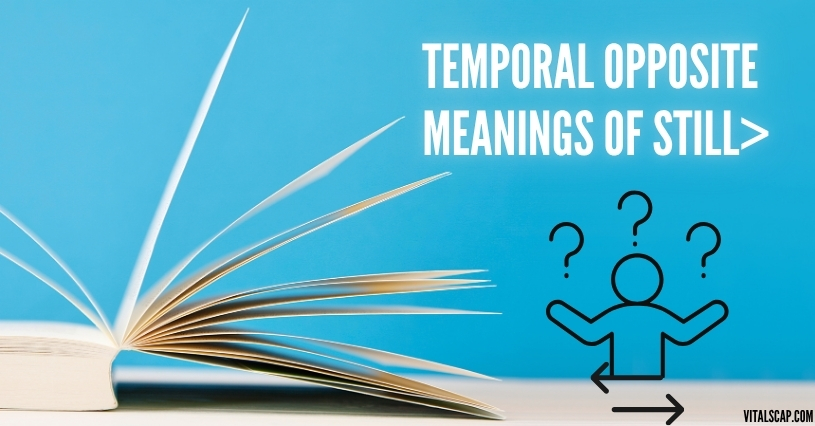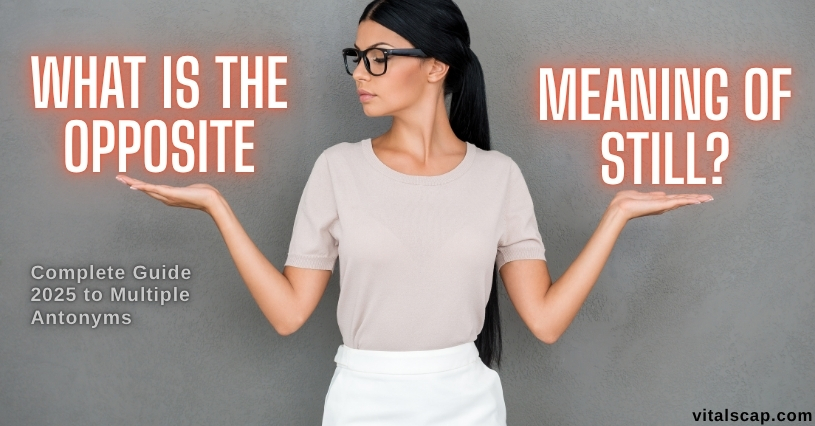The word “still” creates confusion for millions of English speakers daily. You’re writing an email and need the perfect opposite, but which word fits? Motion, movement, or something else entirely?
Understanding the opposite meaning of still isn’t straightforward because this versatile word carries multiple definitions, each demanding different antonyms. Whether discussing physical stillness, temporal continuity, or logical contrast, context determines everything.
When Still Means Motionless
Physical stillness represents the absence of motion and movement. When water remains perfectly still, it lacks vibration, disturbance, or agitation. The dynamic opposite creates turbulence and energy through constant change and action.
The most direct opposite of still (not moving) is “moving.” Picture a tranquil lake at dawn versus choppy ocean waves. Still water reflects like glass, while moving water dances with energy and creates noise. This contrast illustrates the fundamental difference between stillness and motion.
Active serves as another powerful antonym when discussing physical states. An active person displays restlessness and constant movement, while someone remaining still shows calm and motionless behavior. The vibration of active life opposes the pause of stillness.
| Physical State | Still Synonyms | Opposite Words | Context Example |
| Water | Calm, Tranquil, Peaceful | Turbulent, Choppy, Agitated | Still pond vs. rushing river |
| Person | Motionless, Stationary, Fixed | Active, Moving, Restless | Still meditation vs. active exercise |
| Air | Quiet, Undisturbed, Serene | Windy, Blustery, Turbulent | Still morning vs. stormy weather |
Dynamic opposition creates the strongest contrast to stillness. Dynamic systems demonstrate constant change, energy, and movement. This semantic relationship shows how motion and stillness exist as fundamental opposites in English language usage.
Temporal Opposite Meanings of Still

Temporal stillness indicates continuity through time rather than physical motion. When someone says “still waiting,” they express ongoing action without pause. The opposite meaning shifts dramatically from physical antonyms to time-based concepts.
“No longer” serves as the primary temporal opposite of still. “She’s still working” becomes “She’s no longer working” to show completed action. This semantic transformation demonstrates how context changes meaning entirely. Another word for still happening might be “continuing” or “ongoing.”
“Already” functions as another temporal antonym. “Still waiting” contrasts with “already arrived” to show completion versus continuity. “Finally” also opposes temporal stillness by indicating an end to waiting or ongoing action.
The Hindi meaning of still (अभी भी) and the Urdu meaning (اب بھی) both emphasize temporal continuity. These translations help non-native speakers understand how different languages express ongoing action versus completed states.
Logical Opposite Meanings of Still
Logical stillness appears when still means “nevertheless” or “however.” This usage creates contrast rather than agreement. “The weather was terrible; still, we hiked” shows opposition to expected action. The opposite meaning involves a logical connection rather than a contradiction.
“Therefore” serves as the primary logical opposite of still. Where it still creates contrast, therefore shows cause and effect. “It rained; therefore, we stayed inside” demonstrates logical progression rather than opposition. This semantic shift changes the meaning completely.
“Consequently” and “thus” also oppose logical stillness. These words connect ideas through logic rather than contrast. But still, synonyms include “nevertheless,” “however,” and “nonetheless” – all creating opposition to expected outcomes.
Grammar affects meaning significantly. Still at sentence beginnings creates stronger contrast than mid-sentence placement. American English preferences lean toward clear logical connections, making proper antonym selection crucial for effective communication.
More posts: What Is the Medical Meaning for DTF? Complete Guide to Medical DTF Terminology
Synonyms of Still
Still, synonym and antonym relationships reveal complex semantic connections. Physical stillness synonyms include motionless, stationary, immobile, and static. These words share similar meaning while maintaining distinct usage patterns in different contexts.
Peaceful, tranquil, calm, and serene represent emotional stillness. These synonyms describe mental states rather than physical motion. Understanding these distinctions helps identify appropriate opposites for specific situations. Another word for still there might be “remaining” or “present.”
Nevertheless, synonyms include however, nonetheless, yet, and but. These logical connectors create contrast between opposing ideas. Temporal synonyms like ongoing, persistent, and remaining indicate continued action through time.
- Motion-based synonyms: Motionless, stationary, immobile, static
- Emotional synonyms: Peaceful, tranquil, calm, serene
- Logical synonyms: Nevertheless, however, nonetheless, yet
- Temporal synonyms: Ongoing, persistent, remaining, continuing
Fixed, steady, stable, and unmoving describe permanent stillness. These words suggest resistance to change or movement. Identifying synonyms helps recognize appropriate opposites for each context.
Calm vs. Chaos Opposites

| Calm/Still States | VS | Chaotic/Opposite States | Context Example |
| Peaceful | vs | Turbulent | Peaceful meditation vs turbulent thoughts |
| Tranquil | vs | Agitated | Tranquil lake vs agitated ocean waves |
| Serene | vs | Frenzied | Serene morning vs frenzied rush hour |
| Quiet | vs | Noisy | Quiet library vs noisy construction site |
| Composed | vs | Restless | Composed speaker vs restless audience |
| Stable | vs | Volatile | Stable mood vs volatile emotions |
| Balanced | vs | Erratic | Balanced lifestyle vs erratic schedule |
| Harmonious | vs | Discordant | Harmonious music vs discordant noise |
| Undisturbed | vs | Disrupted | Undisturbed sleep vs disrupted rest |
| Steady | vs | Fluctuating | Steady breathing vs fluctuating heartbeat |
| Placid | vs | Stormy | Placid personality vs stormy temperament |
| Motionless | vs | Dynamic | Motionless statue vs dynamic dancer |
American English Usage
American English demonstrates regional variations in still usage and preferred antonyms. Southern dialects often emphasize temporal stillness with phrases like “still fixing to go.” Northern regions prefer direct opposites like “moving” or “active” for physical contexts.
Colloquial expressions shape antonym selection. “Hold still” commonly becomes “move around” in casual conversation. “Still waters run deep” creates metaphorical meaning requiring different opposites than literal stillness. Cultural context influences word choice significantly.
Formal writing demands precise antonyms. Business communication prefers “active” over “moving” when discussing project status. Academic writing uses “dynamic” to oppose “static” in theoretical discussions. Professional settings require careful word selection.
Email communication and social media show evolving preferences. Younger Americans increasingly use “busy” to oppose “still” in temporal contexts. “No longer” remains standard for formal temporal opposites. Regional dialects continue influencing modern usage patterns.
Common Mistakes with Still Opposites
Context confusion creates frequent errors in opposite selection. Readers misinterpret “still” as meaning without surrounding clues. “She’s still here” requires “gone” as the opposite, while “keep still” needs “move” for proper contrast.
Non-native speakers struggle with multiple meanings. Translation errors occur when students apply single antonyms to all contexts.
ESL challenges include identifying the correct meaning before selecting opposites. Practice scenarios help students recognize context clues. “Still working” versus “still water” require completely different antonyms despite identical spelling.
| Common Error | Incorrect Usage | Correct Opposite | Context Type |
| Still waiting | Moving waiting | No longer waiting | Temporal |
| Still water | Therefore water | Moving/turbulent water | Physical |
| Still, I agree | Moving, I agree | Therefore, I agree | Logical |
Reading comprehension improves antonym selection. Students should identify whether it still describes motion, time, or logic before choosing opposites. Cultural differences in language structure affect learning patterns significantly.
Practical Daily Communication Applications
Writing clarity improves through proper antonym usage. Content creators must select appropriate opposites for the intended meaning. “Still editing” becomes “finished editing” to show completion. “Still waters” become “turbulent waters” for physical contrast.
Email effectiveness increases with precise word choice. “Project still pending” clearly becomes “project completed” rather than “project moving.” Professional communication demands accurate temporal opposites for clear meaning.
Social media usage shows evolving preferences. “Still thinking” often becomes “decided” in casual posts. “Still here” transforms to “left” or “gone” for location updates. Modern communication favors conciseness over formal precision.
Meeting language requires careful selection. “Still discussing” becomes “decision made” to show progress. “Still reviewing” changes to “approved” for clear status updates. Business clarity depends on proper antonym usage.
Advanced Usage and Literary Applications
Idiomatic expressions create unique antonym relationships. “Still waters run deep” suggests hidden complexity rather than literal stillness. The opposite concept might be “shallow and obvious” rather than simple motion. Metaphorical usage requires creative antonym selection.
Literary devices are still employed for dramatic effect. The authors contrast “still night” with “chaotic morning” to show emotional change. Poetry uses stillness versus turbulence for symbolic meaning. Creative writing demands a nuanced understanding of all antonym types.
“Still small voice” represents quiet wisdom opposing “loud confusion.” Biblical references and classical literature established traditional usage patterns. Modern writers build upon these foundations while creating contemporary applications.
Storytelling techniques leverage stillness for tension building. “Everything went still” creates anticipation before dramatic action. Writers use temporal stillness to show character persistence against overwhelming odds. Narrative flow depends on proper antonym timing.
Professional vs. Casual Usage

Business writing standards require formal opposites that match the corporate tone. “Ceased operations” sounds more professional than “stopped working.” “Market volatility” is preferred over “choppy trading.” “No longer viable” is better than “doesn’t work anymore.”
Academic contexts demand precise opposites that maintain a scholarly tone. “Kinetic energy” opposes “potential energy” in physics papers. “Dynamic systems” contrast with “static models” in research writing. “Temporal cessation” is preferred over “stopping time” in formal analysis.
Creative writing allows flexibility with opposite selection for artistic effect. Poets might use “stillicide” (dripping) to oppose stillness. Novelists create unique opposites like “soul-stirring” versus “spirit-stilling.” Creative freedom enables innovative oppositional relationships.
Frequently Asked Questions
What is the opposite of still?
Depends on context – “moving” for physical motion, “therefore” for logical contrast, “no longer” for time continuation.
What is another meaning of still?
Besides motionless, “still” means “nevertheless,” “however,” “continuing,” or “even now” depending on sentence structure and context.
What is the opposite of still not moving?
“Moving,” “active,” “dynamic,” “in motion,” “mobile,” or “kinetic” – all indicate physical movement versus complete stillness.
What’s the opposite of “be still”?
“Move around,” “be active,” “stay busy,” “keep moving,” or simply “move” – commands encouraging motion instead of stillness.
What is the opposite of being still?
Being active, moving constantly, staying busy, remaining dynamic, or maintaining motion – states of activity versus rest.
What’s another word for “be still”?
“Stay put,” “remain motionless,” “hold steady,” “keep quiet,” “stay calm,” or “don’t move” – similar commands for stillness.
Conclusion
Understanding the opposite meaning still requires recognizing context. Whether discussing physical motion, time continuation, or logical contrast, each situation demands different antonyms. Master these distinctions to communicate precisely.
Remember: moving opposes motionless still, therefore opposes nevertheless still, and no longer opposes continuing still. Context determines everything in language.
More Post:

Passionate about innovation and growth. Dedicated to managing, optimizing, and creating seamless experiences while supporting diverse content and users with professionalism and clarity every day.








